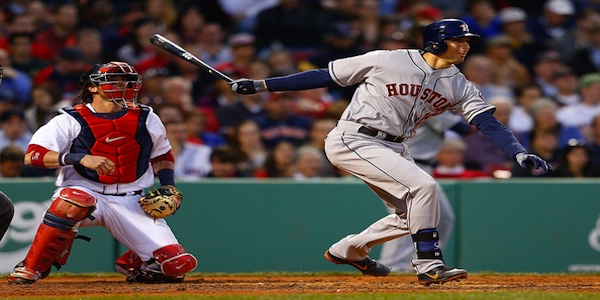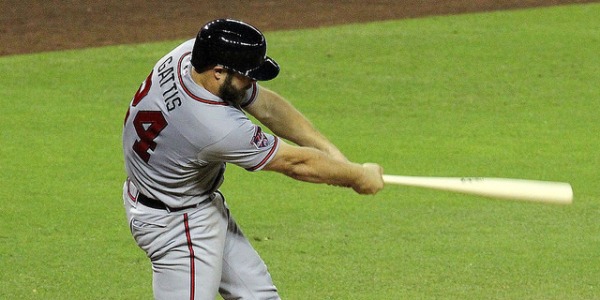2014 Fantasy Baseball: Substitution Value — Catchers

Total run index actually began about five years ago when I began working on a metric I called the Hall of Fame Index. The idea was pretty simple. The idea was to use multiple statistical sources to get the consensus on a player. It culminated in a book I published in 2011 called The Hall of Fame Index. The book was nominated for the Sporting News Award that year at the annual SABR convention. Unfortunately, it did not win, but it was well received, so I figured I was on to something.
So, I began working on total run index in the hopes of selling it to teams. The concept was the same, but I broke down player performance into three different categories: hitting, base running, and fielding. The reception for that was also lukewarm, but when I eliminated the fielding number I discovered I had a pretty good fantasy tool on my hands. I wasn’t disappointed, but it also in my nature to tinker. The HOF Index went through several formulas and the current total run index has as well. The primary problem from a fantasy perspective is that TRI does not do a particularly good job of allowing for differences in what we might call positional scarcity. In other words, there are naturally more good outfielders and first baseman than there are shortstops or catchers.
So, this offseason I made a simple calculation change beyond the basic TRI. Most leagues have twelve teams, so I simply took the median score at each position among the top 24 players at each position (60 starting pitchers and 48 relievers). Add it all up and you have what I call the substitution values for the top 300 players in the fantasy draft. Of course, more tinkering will happen as we move forward, but the end result is a decent look at a player’s relative value across the positions.
The practical application is a lot better than simply ranking the top 300 players according to their raw TRI score. When we use median scores we find that around 150 players will be above zero and the rest will be below zero. It accounts for positional scarcity, so it provides for a much more common sense approach to a fantasy draft. The methodology is simple. You take the player’s raw TRI score (according to their three or five year TRI average) and subtract the median TRI score at that position. As always, a graphical representation of the data will make the concept make a lot more sense.
|
TRI |
POS |
SUB |
|
| Buster Posey |
23.30 |
3.45 |
19.85 |
| Carlos Santana |
18.70 |
3.45 |
15.25 |
| Joe Mauer |
18.00 |
3.45 |
14.55 |
| Yadier Molina |
17.10 |
3.45 |
13.65 |
| Carlos Ruiz |
9.70 |
3.45 |
6.25 |
| Victor Martinez |
9.30 |
3.45 |
5.85 |
| Brian McCann |
6.10 |
3.45 |
2.65 |
| John Jaso |
4.80 |
3.45 |
1.35 |
| Jonathan Lucroy |
4.00 |
3.45 |
0.55 |
| A.J. Ellis |
3.90 |
3.45 |
0.45 |
| Salvador Perez |
3.60 |
3.45 |
0.15 |
| Yan Gomes |
3.50 |
3.45 |
0.05 |
| Miguel Montero |
3.40 |
3.45 |
-0.05 |
| Wilson Ramos |
2.90 |
3.45 |
-0.55 |
| Alex Avila |
2.50 |
3.45 |
-0.95 |
| Jason Castro |
2.30 |
3.45 |
-1.15 |
| Jarrod Saltalamacchia |
1.60 |
3.45 |
-1.85 |
| Wilin Rosario |
1.30 |
3.45 |
-2.15 |
| Welington Castillo |
0.40 |
3.45 |
-3.05 |
| Russell Martin |
-0.80 |
3.45 |
-4.25 |
| Ryan Doumit |
-0.90 |
3.45 |
-4.35 |
| Matt Wieters |
-1.20 |
3.45 |
-4.65 |
| Travis D’Arnauld |
-5.80 |
3.45 |
-9.25 |
| A.J. Pierzynski |
-7.50 |
3.45 |
-10.95 |
Naturally, since the concept behind TRI is to use a variety of sources to get a consensus on a player, I would urge you do the same. TRI probably shouldn’t be used as a singular draft strategy, but it can help identify players that are likely overrated and players that are likely underrated. This can only help you on draft day. For instance, there are players normally picked very high that are on the bottom of the list (Matt Wieters, Wilin Rosario, Jason Castro) and players picked low that wind up near the top of the list (John Jaso, A.J. Ellis, Carlos Ruiz). The most important thing to do is consider why that is the case.
With Matt Wieters and Wilin Rosario the answer is pretty simple. These players play a lot and therefore accumulate some impressive counting statistics. They also do it inefficiently. That is why the index doesn’t particularly like them very much. However, there is something to be said for accumulating numbers. The same is true for those players that find themselves near the top. In particular, John Jaso and A.J. Ellis have struggled for consistent playing time in the past. Is this likely to change or will it continue into the future.
Supposedly, Jaso stands to get some considerable time at DH, so he could find himself getting closer to 400 plate appearances this year. Meanwhile, both Ellis and Ruiz should be their team’s primary catchers. TRI likes all three of those players because they’re proficient at getting on base. If you play in a 6×6 league then it is likely that it includes either walks or on base percentage. Picking one of those players later in the draft could serve you well when other players overpay for guys like Rosario and Wieters.
Where the index falls short is with guys like Jason Castro. Castro had a breakout year last season, but struggled in his first couple of seasons. So, the index does not rate him highly because it considers the three year average. So, his TRI score might be an inaccurate predictor of future performance. Then again, 2013 may have been a career year for him as well. Part of the fun of fantasy baseball is trying to predict the future. Of course, the other part of the fun is managing risk. If TRI is good for anything it is good at indicating where risk exists. Every fantasy champion wins their league when they successfully take risks. Will you be successful taking risks on guys like Castro? Only time will tell.






